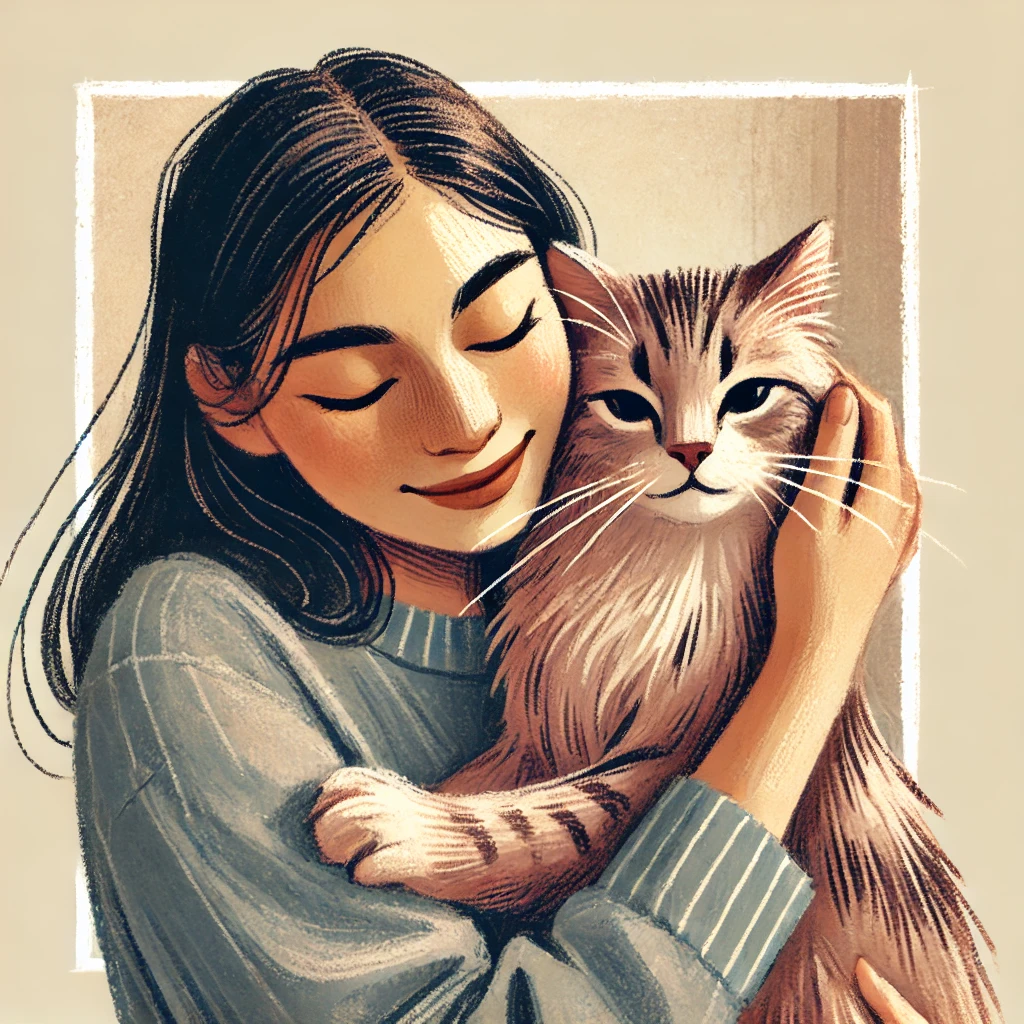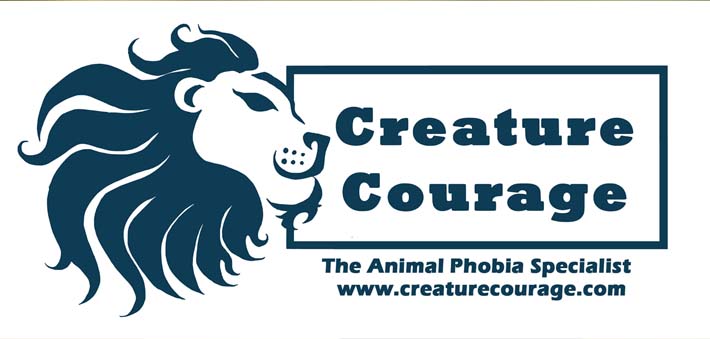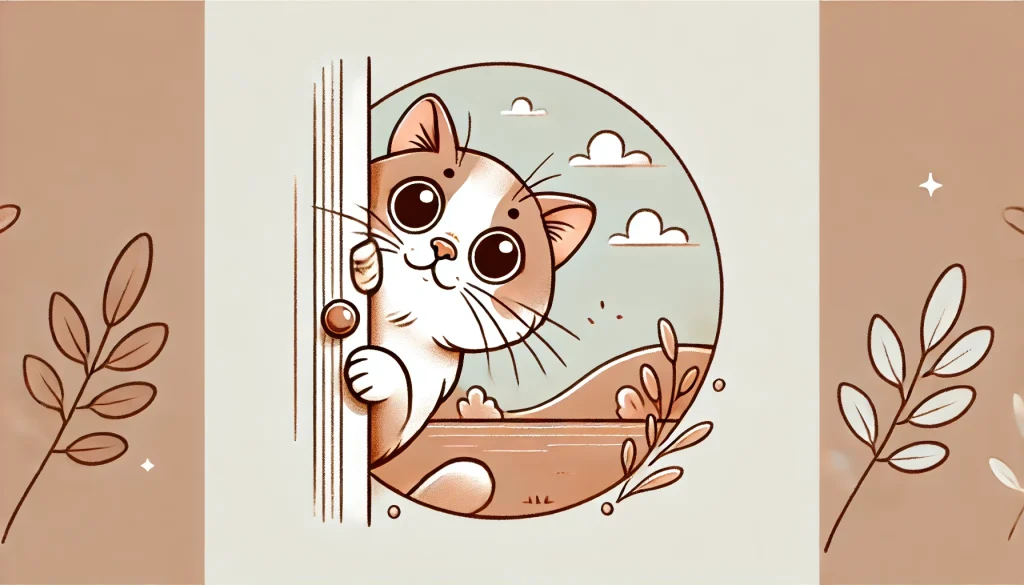Overcoming The Fear of Cats: Ailurophobia
A Powerful Testimony About Overcoming the Fear of Cats
The phobia (or fear) of cats is known as ailurophobia – animal phobias are a type of anxiety disorder developed due to negative experiences or learned behaviours toward animals or objects – in this case, cats.. Our client, Abs, was raised in a family that didn’t particularly like animals, which is probably where his unease around cats began. However, as a child, he was also startled by a cat hissing at him. From his general unease around cats, he began develop a full-on fear of cats. The longer this went on the more anxiety he built up about cats, worrying about whether another cat would hiss at him, did all cats not like him or was it just that one? When he realised that his fear of cats was developing into a fear of animals in general, he decided enough was enough, he needed help!
Find Out How to Overcome Your Fear with Creature Courage
His fear of cats had urned into anxiety throughout his life. He had become a nervous person and was suffering paranoia around animals – sometimes he was afraid to go out at all, you never know, there could be a cat around any corner. Ailurophobia was the main consideration to him going anywhere, and it was getting in the way of his social and family life. Some of his friends and family had pet cats, which, again, caused awkward situations. His friends would have to put their cats in cages or closed away in other rooms, before they could welcome Abs over. They were happy to do that, Abs is a great guy, but it was their house and it was becoming a barrier to their friendship – of course, this is to assume that Abs could work up the courage to turn up in the first place. Clearly, this was not just hampering Abs’ life but the life of his friends and family, too.
By now, you might be able to appreciate, his cat phobia was also affecting his holiday plans. He didn’t really want to travel anywhere he didn’t already know inside/out, sometimes, even walking down the road was becoming problematic. He fall asleep visualising his day ahead, planning the route he’d walk to minimise chance encounters, imagining all the places a cat could lurk: under a car, on top of a fence, was it bin day because they could easily be behind them and, therefore, on the pavement as he walked by. Best not risk that route, let’s start again. Evidently, something needed to change.
The Decision to Break Free from Fear

When Abs came to see us, he was about to get married. He wanted to ensure that his wife to be, and the family they were planning, would not associate cats with his fear. The thought of them suffering his extreme anxiety around cats, was not something he wanted to put them through. Abs knew the how the increased stress from the phobia could develop into additional anxiety around other aspects of life. Above all, he wanted his children to enjoy their life, animals included. And who knew, his children might love cats, he knew he needed to prepare!
When Abs came to Creature Courage he knew what he wanted, but like so many others, he didn’t know how to do it, and because of this he never dreamed that by the end of the session that he would not only be able to stand in the same room as a cat, but also have one on his lap!
The session with Abs, and the sleek and friendly oriental cat Koumori, was simply transformative. In just a few hours of talk therapy and guided relaxation Abs felt calm enough to begin exposure therapy. In no time, Koumori was curled up and purring on his lap. It was amazing, not unexpected from our point-of-view, but there was no fear or anxiety from Abs, he was calm and content with the cat right there on his knee. He said he felt his phobia of cats was cured.
Overcome Your Fear of Cats in Just One Day
Months later, the breakthrough is still everything Abs had hoped for. He’s reclaimed his everyday life and feels much more confident in any given situation. Once away from the controlled environment of our exposure therapy, we advised him to spend as much time as possible with his friend’s cats. He needed to keep this exposure and confidence going, no more shutting cats away in bedrooms when he went to visit. It wasn’t about picking up a cat and stroking it every time, but just living a normal life without anxiety or hesitation. With focused attention and working through the relaxation techniques he’d learned, he has formed a new approach to his cat encounters. He did it and there’s no question that you can, too!
Understanding Your Fear of Cats
What is Ailurophobia?
As we’ve discovered, Ailurophobia is an intense and irrational fear of cats. The phobia can manifest in a variety of ways: from mild fear and discomfort to suffering full-blown panic attacks when in the presence of a cat. Although the exact reason may differ from person-to-person, when you develop Ailurophobia it can significantly impact your daily life and relationships. As we discovered with Abs, cats are one of those animals that are truly hard to avoid: they roam freely across wide areas, you can’t seal off your garden from their presence, and they are one of the most popular pets in the UK. This means that when you suffer from a fear of cats, you become afraid of going out and, even, taking a walk in your own neighbourhood can become a testing experience.
Prevalence of Cat Phobias
It is suggested that Ailurophobia affects more people than you might expect, with research suggesting that about 12% of female and 3% of male adults suffer from an animal phobia. That said, it’s far more likely a cat will be scared of your vacuum cleaner than you are of them – that’s not suggesting that carrying around a vacuum cleaner everywhere you go is a good form of therapy (actually, I think you might need other forms of therapy if you’re doing that).
Anyway, despite the prevalence of cats within our society, many people do not seek treatment. Many are embarrassed abut what others will think if they find out they are afraid of what is considered the cutest of animals, but others lack of awareness of available therapies and how simple and fast a solution to their problem can be. Understanding and addressing ailurophobia can significantly improve your quality of life and mental well-being.
Causes of Ailurophobia
Ailurophobia, alongside other phobias, often stems from a negative experience with an animal. For example, a frightening cat encounter in childhood, like that suffered by Abs, can trigger long-term anxiety and an excessive fear of cats. Also, cats move in unpredictable ways, and like most animal phobias, Ailurophobia is rooted in the fear of the unexpected and being out of control. As someone who lives next door to a cat family, Luna is as likely to be sitting in our garden or back-step as she is on her own. Kittens can also bite or scratch, especially during play, which can frighten a child and leave a lasting fearful impression.
Many people learn their fear of cats from their parents, siblings or other caregivers. In the first years of our lives we are very observant of the actions of adults around us. One of the ways we grow, learn and develop as children, is through watching how our parents and caregivers respond to the world around them. It’s often said we are sponges, and it’s rightly true that we will usually mimic any fearful response they might give to a particular stimuli.
As if that wasn’t enough, being brought-up in an environment where cats are disliked, even without being present, can just as easily reinforce a fear. Cats have been and still are associated with evil and superstition. This has grown here in the UK over recent years but is embedded across other cultures and, indeed, many of our clients with a cat phobia moved to the UK from cultures that have a completely different attitude towards cats. Cats have long been seen as pests and forebears or evil instead of the cute social media stars that are have so many in their thrall.
Historical context plays a significant role. Cats being seen as evil stems back to the church in the middle ages, due to some vague connection to paganism. During the Salem Witch Trials in the the late-1600s black cats were believed to be witches in disguise – a bizarre belief that has somehow seeped into popular culture today – reinforced by our media and entertainment.
Dispelling Widely Believed Myths About Cats
Cats have been the subject of myths and superstitions throughout history. One persistent myth is that black cats bring bad luck. However, there is nothing unlucky about a black cat at all – just don’t walk under a ladder whilst smashing a mirror with a black cat walking across your path (although if you stick it on YouTube it’s bound to get a few views). Sorry, let’s get back on track. Despite how silly superstitions tend to sound, so many people believe them that black cats are the least likely to be adopted – it might sound ridiculous but it’s absolutely true.
And if you are still looking for a bigger stick to hit cats with: during the plague, cats were very much wrongly blamed for spreading disease, which led to persecution. The reality is that, cats greatly helped control the rat population and, in doing so, the plague was more quickly contained.
Another myth about cats is that they they are cold, aloof, and selfish creatures. People think that cats do not truly love or care about their owners, only seeing them as an easy provider of food. This notion has come about due to our love of dogs and the clear devotion they show us, which is not similarly shown by cats. Yet, studies clearly show that cats share the same attachment to us as small children to their parents, and there are countless stories of cats becoming heroes, risking their lives to save their human companions and other animals. You can read some of these here.
The Truth About Cats & Their Positive Impact on Our Lives
Cats are affectionate and helpful animals, and if you own a cat you’ll happily attest to it. There is not one single cat that brings any inherent bad luck, regardless of its colour. It’s understanding and dispelling these myths that will help reduce irrational fear. In fact, as we’ve just touched on, cats have a history of helping humans, and they bring much good into our lives when we share our lives with them.
How Have Cats Help Us?
Cats have helped humans evolve and survive through helping us hunt and drive away rodent pests and the disease they carry. We couldn’t have progressed from hunter gathers to farmers without the assistance of cats. Even today, they are still the most effective rodent control available as just the presence of a cat will keep rodents at bay. Further, as our connection with them has grown, they now bring us joy and comfort in their affection and loyalty. Indeed, many highly emotional people feel cats provide greater support than dogs when suffering stress.

Why Cats Are The Best Pest Control
Cats are natural hunters and this means that you don’t need to leave a trap out and hope a dopey rodent accidentally gets caught, but that the cat will go looking for them and you never need to worry. Cats help you maintain a clean, pest-free environment – they are the best rodent control option available.
Cats succeed where traps and poison fail. Agile and nocturnal, they hunt in minimal light, which isn’t great news for their prey, as rodents are also most active at night and face the perfect nemesis in a cat. Cats not only kill rats but they also deter other rodents from coming into the territory by marking it with their scent. Just a cat’s scent is enough to make rats scatter. As a rodent control, it’s nearly 100% effective – the only long-term, permanent solution.
How Cats Provide Emotional Support
Dogs are always seen as more devoted to us, happier to be around us, and perfect as a support animal that puts our needs first – I mean, you’d never entrust a cat to guide a someone who was blind safely down the street! Like many preconceptions of the animals in our world, cats do provide us with companionship and emotional support, which has been comprehensively shown to improve our mental health. Cats help reduce our stress, anxiety, and depression – one of the reasons we find exposure therapy to be so important in overcoming fear – the simple act of petting a cat releases endorphins and oxytocin which promotes happiness and relaxation.
Find Out How Exposure Therapy Can Help You

What Are Health Benefits to Cat Ownership?
Owning a cat can offer physical health benefits, too. Research indicates that cat owners have a lower risk of heart disease and stroke, and the calming presence of a cat can lower blood pressure and improve overall cardiovascular health. If you think that’s impressive, wait until you find out that, while a cat’s purr is commonly linked to feelings of comfort and calm, the vibration of a cat’s purr has been found to heal injury and reduce inflammation! Absolutely crazy.
Interesting Facts About Cats
- Exceptional Balance: If you’ve ever seen a cat walking easily along the top of a fence, then you’ll know that cats have an exceptional sense of balance and agility. This is crucial for them to search for prey and, indeed, escape from predators or to navigate difficult environments with ease
- Pinpoint Hearing: Cats have remarkable hearing, able to hear frequencies three times higher than the human ear. This ability ability helps them hear the faintest shuffling of a rodent, whilst out hunting. Better yet, it even allows them to pinpoint that noise and hone in precisely on their prey. Sadly for them, much like us, a cat’s hearing deteriorates as they age
- Deep Sleeping: The term cat-nap wasn’t coined by chance, cats can even make teenagers envious when it comes to sleeping. Cat’s average between 13-16 hours sleep-a-day, reserving most of their energy for hunting
- Sensitive Whiskers: A cat’s whiskers are highly sensitive to sound vibrations, air pressure and touch. Along with their exceptional hearing, they use their whiskers to further help with their incredible night-time navigation
- Communication: We’re all familiar with a cat’s meow, however, they actually have a variety of vocalisations that allow communication with other cats, humans and other animals.
- Unique Nose Print: Did you know that each cat’s nose print is unique, much like a human fingerprint – although they can’t open a phone lock with it
- Ancient Companions: Cats have been domesticated for around 9,000 years, that’s a long time to spend with us, so it’s little wonder that they are so adored a companion. Evidence of their companionship dates all the way back to ancient Egypt
- Fast Reflexes: Keeping themselves dosing on the radiator all day allows cat’s to summon super-fast reflexes when needed most. Though they tend not to expend much energy where possible, cats can run up to 30 miles-per-hour in short bursts, showcasing their impressive agility and speed, and displaying how they are such successful hunters
- Water-Resistant Fur: Some cat breeds, like the Turkish Van, have water-resistant fur and enjoy swimming – that’s right, no typo, a cat that genuinely likes swimming
- A Third Eyelid: Almost unbelievably, cats have a third eyelid called a haw. This anomaly helps to protect cats eyes in harsh environments, and keeps their eyes moist
- No Collarbone: Cats do not have a collarbone, which is why they are able to squeeze themselves through any space their head can fit through, and why you get stuck when trying to get out from the loft.
- Right Pawed or Left Pawed: Though there isn’t a universal preference, it appears that female cats tend to favour their right paw, whilst males favour their left-paw. The study by Queen’s University Belfast couldn’t come up with a reason why, but they did suggest their was no preference for which side a cat slept on
- Taste Bud Quirk: It’s not only a collarbone that cats lack, they also don’t have the ability to taste sweetness, and are therefore not attracted to sweet foods – go and tell that to Garfield!
- Ancient Hunting Skills: Cats have retained their hunting skills that have seen them survive and thrive for thousands of years – even domestic cats exhibit behaviours like stalking and pouncing
- Unique Grooming Skills: Cats spend up to 50% of their waking hours grooming, which is more than your average Instagram influencer (believe it or not). This grooming habit allows them to better regulate their body temperature and keep their fur clean
- Nose as a Communication Tool: Cats often greet each other by touching noses, which is a way of exchanging scents and establishing familiarity
- Lifespan: Domestic cats typically live between 12-15 years, though some can live well into their twenties with proper care. This means they are long-term companion animals. They are known for their independence but they are also capable of forming strong bonds with their human companions. Each cat has a distinct personality, making them unique members of any household.
Overcoming Cat Phobia: Effective Strategies and Exposure Therapy
The best way to overcome your cat phobia involves a combination of gradual exposure therapy and other therapeutic techniques tailored to address the underlying causes of fear. Gradual exposure, also known as desensitisation, allows you to be slowly introduced to a cat within a safe and controlled environment. The method builds tolerance and reduces your anxiety over time.
In our particular exposure therapy, we begin with pictures or videos of cats and progress on to observing them from a distance. Eventually, and under our control, we can begin the steady process of interaction with a calm and friendly cat. This helps to break down the psychological and physical symptoms that cause panic. We allow your survival instinct to understand that cats are not a threat and, to then, form new positive memories with cats. In doing it in this way we dismantle your cat fear and help you overcome cat fear for good.
Creature Courage: Effective Treatment for Cat Phobia
At Creature Courage, we not only offer and use exposure therapy, but we include a comprehensive combination of techniques to effectively treat animal phobias.
- We complement exposure therapy with Cognitive Behavioural Therapy (CBT), which we find to be highly effective. CBT helps you to identify and challenge irrational thoughts and beliefs about your specific phobias, and gives us the chance to help you replace your fears with a more realistic and positive outlook.
- Neuro-Linguistic Programming (NLP) is further used to transform subconscious trigger symptoms that cause anxiety disorders. From this we can help you create more positive associations.
- Our education about cat behaviour and dispelling common cat myths can help reduce anxiety symptoms through fostering understanding and empathy. Beyond this, our education helps clients see more clearly how their fear of cats is connected to their wider anxiety. This teaches healthier habits around all anxiety triggers to improve overall mental health and to further assure lasting results.
- We also use a variety of meditative imagination exercises to create compassion and good feelings around cats. We often use an art therapy exercise to solidify the experience in a lasting way.
- Hypnotherapy delves into the deep-root cause of your specific phobia on a subconscious level. Hypnotherapy helps to rewire your brain to a different reaction to cats and helps to diminish any irrational fears. Furthermore, it puts you in a very relaxed state before exposure therapy which achieves the very best results.
The Value of Our Animal Phobia Therapy
Professional help, such as the holistic approach offered by Creature Courage, ensures that all aspects of your cat phobia are addressed. Our comprehensive strategy not only helps you overcome your fear of cats, but also equips you with a full tool-belt to manage anxiety and improve your overall mental well-being.
Clients often report an increase to their confidence and resilience when facing other challenges. Moreover, our supportive and nurturing environment fosters personal growth and emotional strength, leading to lasting positive changes. This comprehensive approach ensures that you will leave our therapy not simply free from your own specific phobia but that you will be better prepared to handle life’s broader spectrum of anxieties.
Our unique approach allows for quick and effective results, as testified to by numerous happy clients.
Get Over Your Fear of Cats For Good
FAQ: Overcoming Cat Phobia
What is ailurophobia? Ailurophobia is the intense and irrational fear of cats.
How common is ailurophobia? While exact statistics are hard to pinpoint just for a fear of cats, it is estimated that about 10 million people suffer with some form of animal phobia in the UK alone.
What causes ailurophobia? Ailurophobia often stems from negative experiences with cats, particularly during childhood, or being raised in an environment where cats are viewed negatively.
How can I overcome my fear of cats? Effective treatments include cognitive behavioural therapy (CBT), exposure therapy, Neuro-Linguistic Programming (NLP), hypnotherapy, art therapy and education.
How long does it take to overcome ailurophobia? Most people who undertake therapy with Creature Courage see significant improvement in just one day!.
Are cats dangerous? Cats are generally not dangerous. Understanding their behaviour and dispelling myths can help treat phobias.
What are the benefits of owning a cat? Cats provide companionship, emotional support, and health benefits, such as reducing stress and improving cardiovascular health. They also help control pests like rodents.



